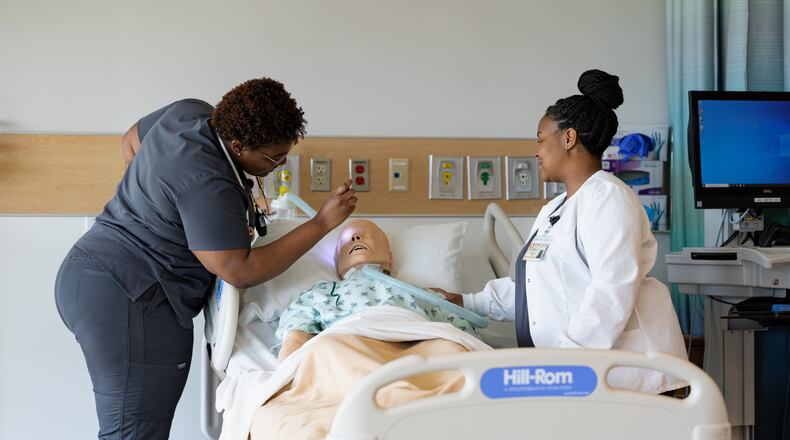Nurses are still facing high patient loads and mandated overtime that is causing greater stress, said Robert Weitzel, president of the Ohio Nurses Association. This may be causing churn among open nursing positions as workers enter and leave the workforce, he said.
“Around 100,000 nurses have left the bedside since the pandemic started due to burnout (and) unsafe working conditions. States where safe staffing mandates are have enticed some nurses to return back to the bedside,” Weitzel said.
U.S. Sen. Sherrod Brown visited Dayton in April to advocate for federal legislation that would set minimum nurse-to-patient staffing standards. That follows similar limits being set in California.,
“Two-thirds of staff nurses in California said that state ratio laws make them more likely to stay at their jobs and 74% say that it has improved quality care in that state,” Weitzel said.
He cited other similar staffing ratios being mandated in states like Oregon, Washington, and Connecticut.
Those representing hospitals say flexibility is needed with patient-staff ratios.
“GDAHA hospitals prioritize patient safety alongside the well-being of their dedicated staff and employees. While staffing ratios have been proposed as a solution to improve patient safety and retain nurses in acute care settings, delivering care in a hospital setting requires operational nimbleness to respond to a dynamic and complex environment,” said Sarah Hackenbracht, president and CEO of the Greater Dayton Area Hospital Association (GDAHA).
That flexibility is needed to provide optimal care, she said.
“Implementing rigid nurse staffing ratios can limit a hospital’s ability to allocate resources efficiently based on the unique requirements of their overall patient population. Hospitals require the autonomy to adjust staffing based on patient acuity and individual care plans,” Hackenbracht said.
The Ohio Nurses Association says mandated patient-to-nurse ratios would help nurses give each patient more attention. Patients at hospitals with staffing limits — typically four patients to one nurse patients — were less likely to be re-admitted within 30 days, Weitzel said.
Hospitals say they need “evidence-based staffing models that consider the specific needs of each hospital,” Hackenbracht said.
“Collaboration among health care professionals, including nurses, physicians, and administrators, is essential to making informed staffing decisions that enhance patient outcomes while ensuring the safety and satisfaction of our clinical and non-clinical staff,” Hackenbracht said.
Hospitals in the Dayton region partnered in 2019 to share best practices on providing support for work-related stress and burnout, Hackenbracht said.
“When revisited in 2021, during COVID-19, trauma also emerged because of the devastating losses of patients and peers that healthcare workers experienced. Hospital leaders are consistently engaging their workforce to identify problems and develop actionable solutions, such access to trained emotional support staff (crisis counselors, faith leaders, etc.) during and after a challenging event,” Hackenbracht said.
The health care workforce is continuing to grow in the Dayton region. Premier Health and Kettering Health currently have more than 4,800 open positions each, according to Ohio Means Jobs.
“Health care is a sector of our region’s economy that is consistently hiring because of the overall commitment to serve the health care needs of our communities,” Hackenbracht said.
Some areas of health care were experiencing higher vacancy rates prior to COVID-19, which exacerbated the issue, she said. The industry is also experiencing more Baby Boomers retiring.
“Health care organizations will have to remain nimble and attractive to current and future generations of workers to fill vacancies across an organization. Looking to the future, the American Hospital Association projects continued growth in almost all sectors of health care delivery, but higher growth in outpatient, ambulatory surgery, and home care,” Hackenbracht said.
Educational institutions are also continuing to expand their options for students. Sinclair Community College has increased the students it admits in areas where there are critical workforce shortages, such as respiratory therapy, radiologic technology and dental hygiene, in partnership with area health care institutions.
“We’ve increased the number of students by 20%, and we were able to do that only because our employers are supporting us with clinical experiences, so if we didn’t have that partnership, we couldn’t do the increase in admission,” said Dr. Rena Sebor, dean of health sciences at Sinclair Community College.
They are also bringing a focus to both the patient and the provider’s wellness, Sebor said.
“The pandemic has certainly created burnout in our current and existing health care workforce. It’s also made those who may have once upon a time been interested in health care question if it’s for them, but we have focused our curriculum and our newer curriculum on integrating trauma-informed care into some of the programs,” Sebor said.
Trauma-informed care takes into consideration the patient’s past experiences and traumas, as well as recognizes the provider’s wellness is also important in order to provide optimal care.
“The wellness of the provider is also considered, and that was highlighted when we were working with our hospital employers on designing our new Bachelor’s of Science and Nursing degree,” Sebor said.
About the Author


